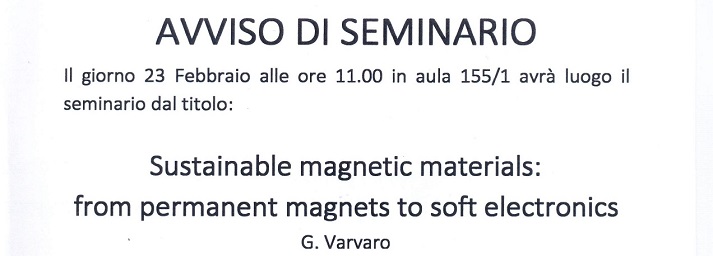Two examples of magnetic materials with zero or low critical raw material content of interest for new generation permanent magnets and advanced electronic devices will be reported in this conference. A novel, effective and high-promising chemical synthesis route will be discussed for the preparation of magnetically hard L10-FeNi alloys made of abundant and easily recyclable Fe and Ni elements, which may be used for the fabrication of sustainable permanent magnets that can gain large market share at the expense of the current high-performing rare-earth-based permanent magnets. Then, the main features of spin-based thin film heterostructures on flexible tapes containing no critical elements (e.g., Ni, Cu) in place of commonly used Pt-group metals, will be discussed to show that responsible soft electronic systems of interest for wearable devices, robotics, and biomedicine can be obtained by properly designing the material.
Biosketch
Gaspare VARVARO (Male, CNR – ISM), PhD in Material Science (2007, University “La Sapienza” of Roma, Italy), works as researcher at the Institute of Structure of Matter of the National Research Council (CNR – ISM), Italy, since 2009, where he directs the Nanostructured Magnetic Material Laboratory (nM2-Lab, www.nm2lab.com). His research activity spans from the fabrication to the characterization of magnetic and magneto-transport properties of nanostructured materials including single-phase magnetic materials, magnetic composites, and hybrid/multifunctional systems (thin film multilayers, nanoparticles, and nano-patterned systems) for fundamental studies and applications (energy and environment, technologies for sensors/actuators, information storage, biomedicine). His research activity was witnessed by more than 80 papers, 4 book chapters, 1 patent and about 120 oral contributions to national and international conferences and workshops (h-index: 23 – Google Scholar; 21 – Scopus). He was co-editor of a book titled “Ultra-High-Density Magnetic Recording: Storage Materials and Media Designs” (Pan Stanford Publishing, 2016). He has been the beneficiary of funds granted on competitive national and international calls (~1200 k€ to date) being currently CNR – ISM Unit Leader of the i) EU ERAMIN 3 Project “Recycling End of Life permanent magnets by innovative sintering and 3D printing” (2022 – 2024), ii) IT-PRIN project “Understanding and controlling magnetic inertia: towards terahertz spin-based technologies” (2022 – 24) and iii) IT E-RIHS.it-Lazio infrastructure project, and work-package co-leader of the IT MISE PON project “Autonomous and flexible manufacturing and augmented reality techniques for processes automation” (2020 – 23). He regularly serves as referee for international journals and as independent expert evaluator for International Projects. He is also involved in education and dissemination activities by training of PhD, master, and high-school students and in the organization of scientific events targeted to the large public and research professionals in magnetism and material science.
